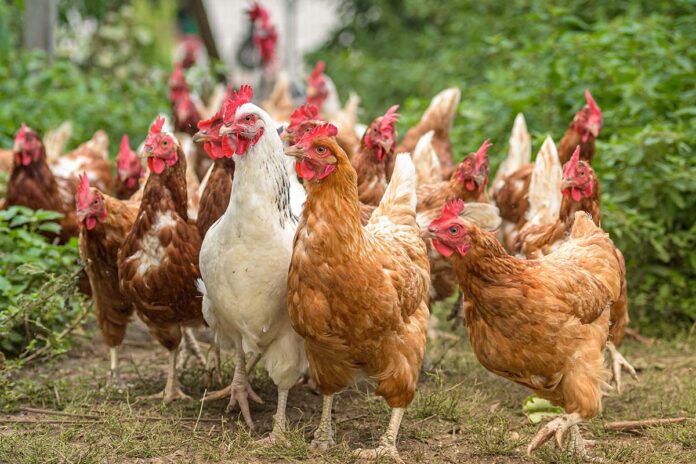
As cage-free systems become more frequent in poultry production, we are forced to evaluate how pest control measures should adapt to ensure efficacy.
The key to insect control is integrated pest management. Simply put, integrated pest management (IPM) is the combination of several insect control measures to combat a pest population, including sanitation, physical barriers, cultural control methods, and insecticides. Three common ectoparasites commonly encountered in poultry facilities are mites, poultry lice, and bed bugs.
Mites
There are several species of mites that attack fowl and usually occur under the feathers. The most important of these species is the Northern Fowl Mites (NFM). Adults are about 1 mm long and dark red to black in color. Most of the life cycle is spent on the bird and under optimal conditions, a single bird can support the development of 20,000 mites in a 10-week time frame. The Poultry Red Mite (PRM), or Chicken Mite as it is referred to in the United States, Dermanyssus gallinae, is another mite species affecting poultry production farms in the United States. The PRM is about 1.5 times larger than the NFM and unlike the NFM, spends most of its time off the bird in cracks of the poultry house. Mite control involves correct identification of species to target harborage areas.
Lice
Lice are classified as either biting lice or sucking lice based on their mouthparts and subsequent feeding habits. Lice attacking poultry are biting lice. Lice will not leave the bird except to pass from one host to the other, which can be more frequent in cage-free systems due to proximity of birds to one another. Characterized by their wide heads, poultry lice will require on bird applications of insecticides. Products that adhere to the bird, such as dusts or oil-based insecticides will be most efficacious for residual control and repellency.
Bed bugs
Bed bugs are an important and emerging pest of poultry production systems. Bed bugs are a cosmopolitan pest that can cause severe cutaneous reactions to both birds and workers within the facility. Bed bugs are particularly difficult to control in poultry facilities due to their excellent hiding capabilities, resistance to insecticides, and their ability to go long periods of time without a blood meal. Without proper control protocols in place, bed bug infestations will become a matter of fact.
Methods for pest control
Integrated pest management in cage-free housing systems will involve the use of several insect control methods; a singular approach will not prove to be the most efficacious or economic. In cage-free housing systems, birds will encounter one another more frequently than in caged facilities and the ectoparasite populations can increase more rapidly than in traditional housing systems.
Over-bird and on-bird applications of insecticides will help with keeping insect populations down while birds are present in the facility. Insecticides approved for over-/on-animal application most often contain pyrethrin or pyrethroid active ingredients and are available in oil-based, water-based, or dust formulations. The difference between over- and on-animal application methods is as simple as the direction of the spray. On- animal applications will be directed downward, toward the bird, while over-animal applications will be fogged into the space above the birds to drift down. Oil-based insecticides are often preferred for on-bird issues like mites, bed bugs and lice because the oil carrying the insecticide will help to penetrate to the skin of the bird better than water and cling to the skin where these ectoparasites frequent. In addition, oil-based applications will prolong the residual effects of an insecticide application because it will not be easily washed off. A supplemental form of on-bird insect control are dust treatments to nest boxes if present.
Premise-applied insecticides will give you more options for control in terms of rotating insecticidal classes of products. Premise insecticides cannot be applied to areas where birds frequent while present in the house unless the insecticide has been given time to completely dry but can offer more residual control. Pits, walls, and exterior areas are great locations for premise-applied insecticides while birds are present.
As a final form of IPM, continuous monitoring of pest populations is integral to ensuring your control measures are working well. For example, there are several bed bug monitoring devices in the professional pest control market that can be utilized in poultry facilities. All insect traps should be monitored, recorded and replaced regularly. Touring the production facility with ectoparasites in mind will help with early detection, insecticide placement, and where to integrate physical improvements to the houses.
Conclusions
Whether you are working with a traditional caged layer configuration or in a cage-free facility, utilizing integrated pest management techniques to keep your flock healthy and ectoparasite free is essential. Applications of insecticides, calculated product use, installation of physical barriers, sanitation, and continuous monitoring of pest populations will keep your birds performing at their highest potential.
From the 2020 Proceedings of the Midwest Poultry Federation Convention

















